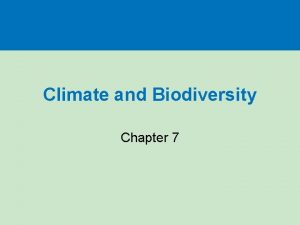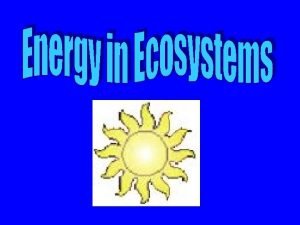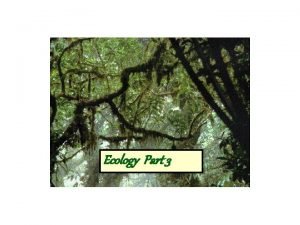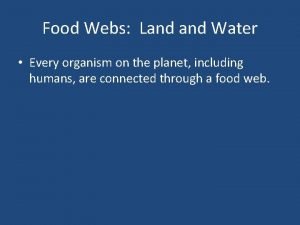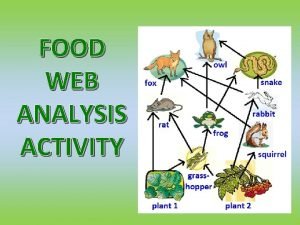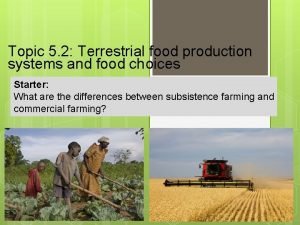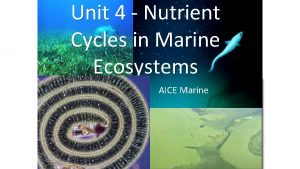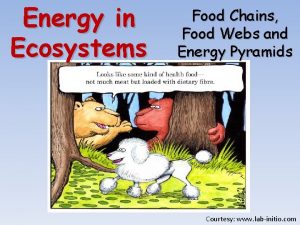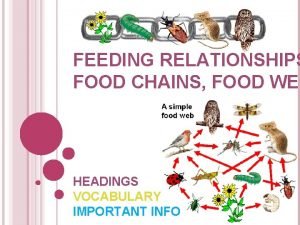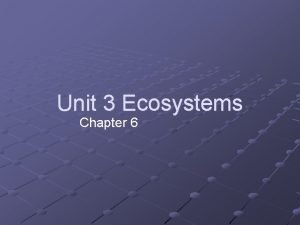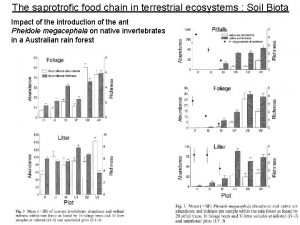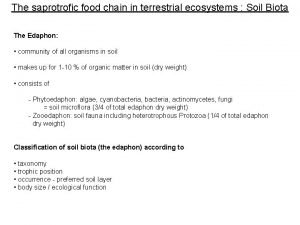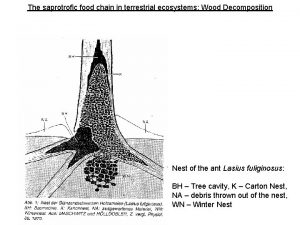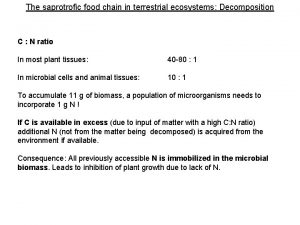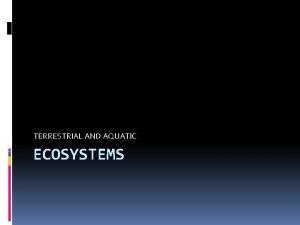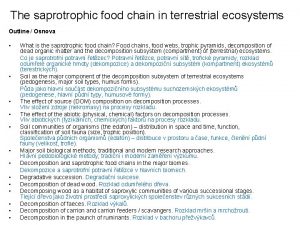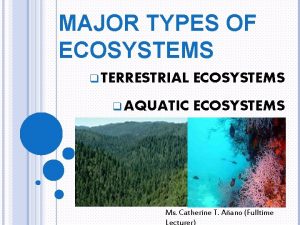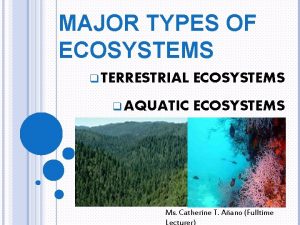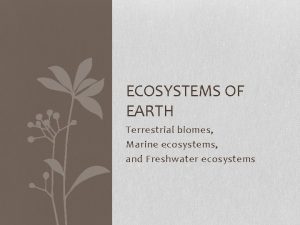The saprotrofic food chain in terrestrial ecosystems Soil

















- Slides: 17

The saprotrofic food chain in terrestrial ecosystems : Soil Biota What controls the community / food web structure? Top-down or bottom-up? (predation or availability of food resources) - Litter enrichment experiments (food, habitat structure, moisture) - Predator exclosure experiments - Mesocosm experiments, e. g. enriching the soil by food sources as glucose to stimulate microbial growth (respiration) What exactly is the trophic position of a given organism? - Food preference experiments (choice) - Analysis of gut content - Direct observation - Labelling of potential food with 14 C (radioactive isotope)

The saprotrofic food chain in terrestrial ecosystems : Soil Biota Using stable isotopes (C, N) to estimate trophic position • 15 N / 14 N ratio (δ 15 N) • Enrichment in 15 N per trophic level in organisms (on average by 3. 4 ‰) • Range of 15 N / 14 N ratios in given community indicates number of trophic levels • 15 N / 14 N increases with soil depth (thus species collonizing deeper soil layers might contain higher 15 N concentrations despite belonging to lower trophic level) • 13 C / 12 C ratio (δ 13 C) • Different ratio in C 3 (e. g. wheat, rye, rice) and C 4 plants (e. g. maize) • Measurement of incorporation of organic matter from defined food source (e. g. C 4 plant litter added to a system based on C 3 plant production)

The saprotrofic food chain in terrestrial ecosystems : Soil Biota Using stable isotopes to estimate trophic position Trophic position and food resources of the soil animal community in two beech forests (Göttinger Wald – on limestone, mull humus, Solling – on acidic sandstone, raw humus)

The saprotrofic food chain in terrestrial ecosystems: Decomposition The effect of resource quality on decomposition rate • Different tissue types have characteristically different decomposition rates • This applies to plant organs as well as to secondary resources as - microbial tissues - faeces and corpses of animals (phyto-, zoo-, saprophages)

The saprotrofic food chain in terrestrial ecosystems: Decomposition • For the same type of tissue there are species-specific differences in the rate of decomposition. A tenfold difference between lowest and highest rates was found in field experiments.

The saprotrofic food chain in terrestrial ecosystems: Decomposition • In a laboratory experiment a threefold range in decomposition was found with mosses at the low and deciduous tree litter at the high end of the range.

The saprotrofic food chain in terrestrial ecosystems: Decomposition measured as weight loss includes losses due to - catabolism, - leaching, - removal or export following comminution. When assessed saparately resource-specif rates are still apparent (see results of litter bag experiment below).

The saprotrofic food chain in terrestrial ecosystems: Decomposition • Differences in patterns of loss due to leaching probably reflect structural differences in the substrates (below: leaves). For instance grinding of spruce litter increased the leaching loss in the first day by ca 10 times (simulation of comminution by soil animals).

The saprotrofic food chain in terrestrial ecosystems: Decomposition • In a natural complex resource, the total weight loss reflects the summation of the decay curves of the individual substrate fractions (theoretical curve S in the chart). • The interaction between the components (and possibly the production of new ones) result in greater resistance to decomposition than predicted by considering the components individually (as indicated by curve M in the chart).

The saprotrofic food chain in terrestrial ecosystems: Decomposition • The weight loss of the total litter and most of its components approximates to a negative exponential function. • Increase in crude protein and lignin: Growth of micro-organisms, N-fixation, in case of lignin possibly alteration of extraction efficiency due to changes in structure of decomposing substance or due to synthesis of lignin-like compounds by micro-organisms (extracted in lignin-fraction).

The saprotrofic food chain in terrestrial ecosystems: Decomposition Carbon and energy sources – requirements of decomposers • Largest quantitative demand: energy released from organic substances and carbon for tissue synthesis. • Plant tissues – high content of polysaccharides vs Animal tissues – high protein and lipid contents • Microorganisms: composition of tissues adapt to high degree to composition of food source! • High demand for N: can lead to N-immobilization in microflora when food-source has high C/N ratio. • Nevertheless, new research confirm that for instance earthworms are limited by C content of food source.

The saprotrofic food chain in terrestrial ecosystems: Decomposition

The saprotrofic food chain in terrestrial ecosystems: Decomposition In absolute numbers the weight loss of polysacharides is high, total decomposition will be determined by cell wall saccharides decomposition.

The saprotrofic food chain in terrestrial ecosystems: Decomposition • The presence of lignin retards the decomposition of cellulose.

The saprotrofic food chain in terrestrial ecosystems: Decomposition

The saprotrofic food chain in terrestrial ecosystems: Decomposition

The saprotrofic food chain in terrestrial ecosystems: Decomposition
 Sequence of food chain
Sequence of food chain Human impact on terrestrial ecosystems
Human impact on terrestrial ecosystems Differences between aquatic and terrestrial ecosystems
Differences between aquatic and terrestrial ecosystems Two or more overlapping food chains
Two or more overlapping food chains Taiga food chain
Taiga food chain Terrestrial food chain
Terrestrial food chain Terrestrial soil
Terrestrial soil Food web analysis worksheet
Food web analysis worksheet Terrestrial vs aquatic food production systems
Terrestrial vs aquatic food production systems Nutrient cycles in marine ecosystems
Nutrient cycles in marine ecosystems Living soil vs dead soil
Living soil vs dead soil Convergent plate boundaries
Convergent plate boundaries Regents biology food chains and energy in ecosystems
Regents biology food chains and energy in ecosystems Bill nye: food webs
Bill nye: food webs Lab food chains and energy in ecosystems
Lab food chains and energy in ecosystems What is the third trophic level
What is the third trophic level Food chain relationships
Food chain relationships Food chain
Food chain

